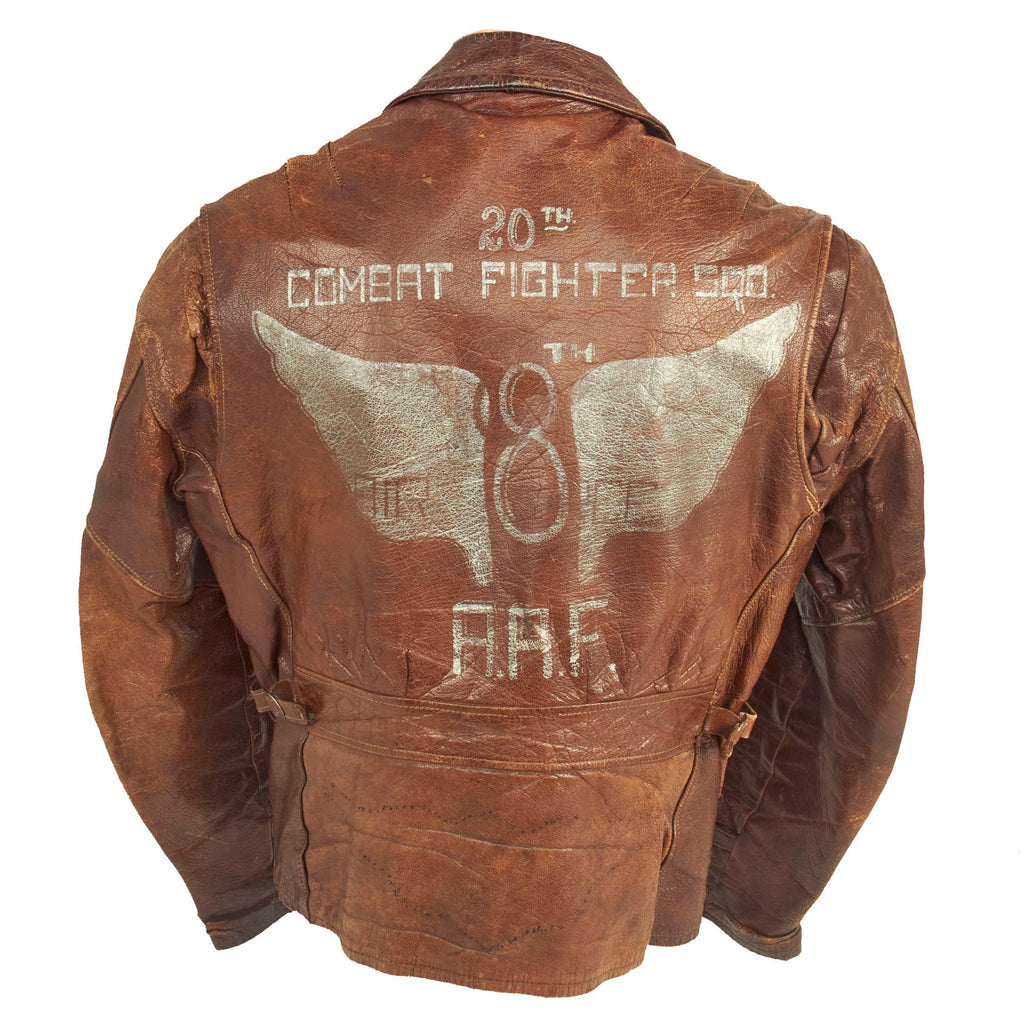-
Painted WWII American A-2 Flight Jackets have realized unprecedented prices in the past year. For example jackets at Rock Island Auctions sold in 2022 for $32,000+ and $23,000+; respectively they can be found at this link and this link. When comparing the Rock Island Auction jackets with the one offered here, one can easily see that our offering is an exceptional value!
Original Item: One-Of-A-Kind. During World War II the 20th Fighter Group was an Eighth Air Force fighter unit stationed in the United Kingdom. It arrived at RAF Kings Cliffe in 1943. It was the oldest USAAF group to be assigned to the Eighth Air Force for an extended period, flying 312 combat missions. It was awarded a Distinguished Unit Citation for a sweep over Germany on 8 April 1944.
This is a really interesting piece of history. This jacket, which is an earkly 1940s British manufactured leather motorcycle jacket, was once owned and personalized by a member of the 8th Army Air Force. One of the most interesting aspects of this jacket is the outline of what appears to be an early Harley Davidson patch located on the bottom of the reverse side. The hand painted artwork on the back is of a rather simple, yet elegant design. It features a large "Winged 8th" flanked on the top and bottom with 20th Combat Fighter Sqd at the top and AAF at the bottom.
There are no markings on the satin interior but this is without a doubt one of the finest leather jackets we have ever had to offer. All buckles, zippers and straps appear to function as intended with the only “issue” being the leather thong missing from the front left breast zipper.
A fantastic painted Motorcycle “A-2” leather jacket ready for further research and display.
Approximate Size: 40
History of the 20th Fighter Group in WWII:
On 11 August 1943, the personnel of the 20th departed California aboard three trains and arrived at Camp Miles Standish, Massachusetts, five days later. From this European staging area the members of the 20th embarked on HMS Queen Elizabeth and departed for the United Kingdom on 20 August 1943. If the members of the 20th had expected a typical Queen Elizabeth pleasure cruise, they were sorely disappointed. The ship had been refitted to accommodate over 19,000 men. Staterooms designed for two or three people had 20 to 30 bunks double and triple stacked for officers and enlisted men. In addition to these conditions, enlisted personnel also served shifts of 24 hours on deck, followed by 24 hours below deck. This doubled the number of personnel the cramped quarters could accommodate. Due to her high speed, the ship traveled unescorted, despite the ever-present threat posed by German U-boats. The five-day trip across the Atlantic was reported as uneventful, except for long chow lines (two meals per day) and frequent boat drills. HMS Queen Elizabeth dropped anchor on 25 August and the men of the 20th disembarked at the Firth of Clyde. From there they were transported to the docks at Greenock, Scotland, and then, by train, to their new home, RAF Kings Cliffe, England.
Fortune smiled on the 55th FS at this time. Due to space restrictions it had to be stationed at RAF Wittering, about five miles from the rest of the group. The facilities there were much superior to those at King's Cliffe. The 55th Squadron joined the rest of the group at King's Cliffe in April 1944. In England, the group was assigned to the VIII Fighter Command. The group was under the command of the 67th Fighter Wing. Aircraft of the 20th were identified by a black/white stripes along their cowlings and tails.
Arriving at King's Cliffe, the group faced the prospect of operating from one of the most primitive airfields in England. The buildings were old and inadequate and airfield facilities were close to nonexistent. The only thing in abundance was poor weather and mud.
Overcoming the initial shock of these conditions the group soon settled in and got on with the serious job of flying. Prior to the 20th's arrival in theater, the Republic P-47 Thunderbolt served as the primary US fighter aircraft in Europe. This aircraft was a formidable match for the German Luftwaffe (Air Force) fighters in air-to-air combat but lacked one important feature—range. Without sufficient range, the conduct of daytime bomber escort missions, first into Europe and then Germany itself, proved nearly impossible. That problem was perhaps best illustrated on 14 October 1943 when 60 of 293 unescorted bombers (20 percent), dispatched against the ball-bearing works in Schweinfurt failed to return from their mission.
- This product is available for international shipping.
- Eligible for all payments - Visa, Mastercard, Discover, AMEX, Paypal & Sezzle


We Buy Military Antiques
Our team expert buyers travels the world to pay fair prices for entire estate collections to singular items.
START SELLING TODAY













